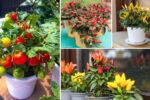Join on WhatsApp
Get the latest updates directly on WhatsApp – motivation, news & more!
Winter is often seen as a time when gardens fall silent. Leaves have dropped, blooms have faded, and the buzz of summer seems like a distant memory. But for many creatures feathered, furred, and otherwise winter is simply another season of life, filled with challenges, adaptations, and the quiet rhythm of survival.
While many gardeners hang up their gloves until spring, there’s something uniquely rewarding about making your outdoor space a refuge for wildlife during the colder months. With just a few thoughtful touches, your garden can become a sanctuary, offering food, shelter, and warmth when nature is at its harshest.
Let’s explore how to make your garden a haven for winter wildlife and why it matters more than ever.
Leave a Little Mess Behind
One of the simplest, yet most effective things you can do is… less. Nature thrives in the mess. That pile of leaves, that patch of dried grasses, those hollow stalks you didn’t cut back in fall they’re not eyesores, they’re lifelines.
Leaf piles become cozy retreats for hedgehogs, frogs, and insects. Hollow stems shelter overwintering bees and other beneficial bugs. Dead wood becomes a feeding ground for fungi and hiding places for beetles. When you resist the urge to tidy everything up, you’re giving wildlife a place to hunker down, rest, and even reproduce.
It might go against traditional gardening instincts, but in winter, untidy often equals alive.
Feed the Birds, Feed the World
Birds are some of the most visible and vocal visitors to winter gardens. While many species migrate, plenty stick around and rely on gardens for food and shelter during the lean months. Setting up a bird feeder is one of the easiest ways to support them.
Black oil sunflower seeds are a favorite for a wide range of birds, from finches to nuthatches. Suet cakes, packed with fat and protein, are especially valuable during freezing temperatures when birds need extra calories to stay warm. Don’t forget about water, either. A shallow dish of fresh, unfrozen water can be more important than food during a hard frost.
Position feeders near shrubs or hedges so birds can dart for cover if predators are nearby. Keep them clean to prevent disease, and try to replenish them regularly once the birds learn your garden is a dependable stop, they’ll keep coming back.
Plant with Purpose
Not all support for wildlife has to come from a bag of seed. If you plan ahead, your garden can be a year-round buffet for hungry creatures. Plants that produce berries, seeds, or nuts provide natural food sources that don’t require human effort once they’re established.
Holly, cotoneaster, and pyracantha offer bright berries that persist through winter and attract thrushes, blackbirds, and waxwings. Native grasses and seed heads from flowers like echinacea, rudbeckia, and teasel offer important nourishment for finches and sparrows. Even ivy often seen as a nuisance can be a crucial late nectar source for pollinators and a winter shelter for birds.
By incorporating plants that serve wildlife in multiple seasons, you create a self-sustaining support system that doesn’t rely entirely on feeders.
Build Winter Shelters
When the wind bites and the frost settles in, wildlife needs places to hide, rest, and sleep. You can help by providing structures that mimic natural shelters or enhancing the ones already in your garden.
A brush pile in a quiet corner can provide cover for small mammals like rabbits, hedgehogs, or voles. Rock piles or stacked logs can house amphibians and insects. A simple hedgehog house or insect hotel tucked beneath a hedge or among shrubs can be a cozy refuge when it’s too cold to move.
Even compost heaps, if managed gently, can serve a dual purpose: breaking down organic matter and offering warmth to hibernating animals. Avoid turning or disturbing the heap during the coldest months so you don’t interrupt any unintended guests.
Let the Lawn Rest
Many of us feel the urge to mow or rake the lawn one last time before winter fully arrives. But resisting that urge can be better for both your soil and the creatures that call it home.
A dormant lawn especially if you let it grow a little longer acts as insulation for overwintering insects and even small animals. The base of tall grass provides shelter from the wind, and a few stray leaves won’t hurt either.
When spring returns, you’ll likely find your lawn bouncing back just fine, and you may have a head start on supporting early pollinators.
Light Less, Live More
Outdoor lighting may be charming in winter, especially around the holidays, but it can have unintended effects on wildlife. Artificial lights can disrupt feeding, mating, and sleeping patterns, particularly for nocturnal creatures like bats, moths, and owls.
If you can, reduce garden lighting to only what’s necessary. Use motion sensors or timers, and opt for warm, low-intensity lights that don’t overwhelm the natural night rhythm. It’s a small change that makes a big difference for creatures that depend on the dark.
Welcome the Unexpected Guests
Sometimes, supporting winter wildlife means being okay with a bit of unpredictability. A fox might wander through in the evening. A squirrel might bury acorns in your pots. Mice might take shelter in a shed. While not always convenient, these moments remind us that we share space with many lives, even if we don’t always see them.
Rather than trying to control every element of your garden, try to observe and adapt. A healthy winter garden is one that pulses quietly with activity even if that activity is tucked beneath snow or curled up under a bush.
By learning to live alongside nature, we don’t lose control we gain connection.
A Garden That Gives Back
There’s something deeply rewarding about knowing your patch of land whether it’s a backyard, balcony, or shared courtyard is doing more than just looking pretty. In winter, when life is stripped back to its essentials, your garden has the chance to be something truly vital: a place of refuge.
Even the smallest changes can ripple outward. A seed left uncut, a bowl of water refilled, a bird feeder hung each action sends a message that your garden is open for life, even when it sleeps under frost.
Winter is not a dead season. It is quieter, yes, and often more subtle. But for the birds, the bugs, the beasts, and even the soil itself, it’s a season of rest, resilience, and hidden beauty. And when you shape your garden with that in mind, it becomes more than a space it becomes a sanctuary.




